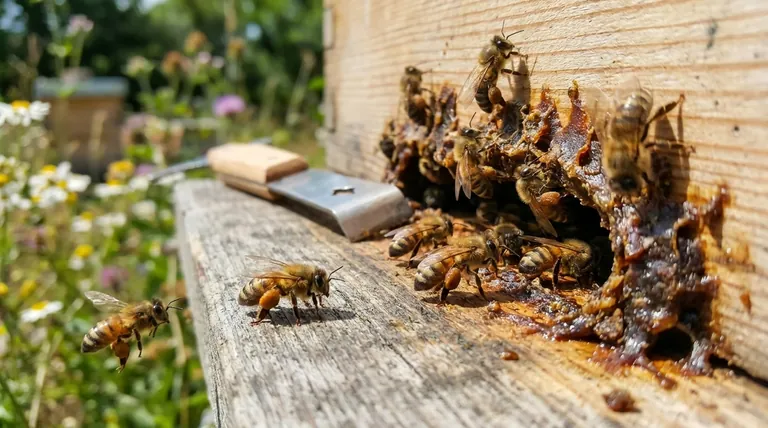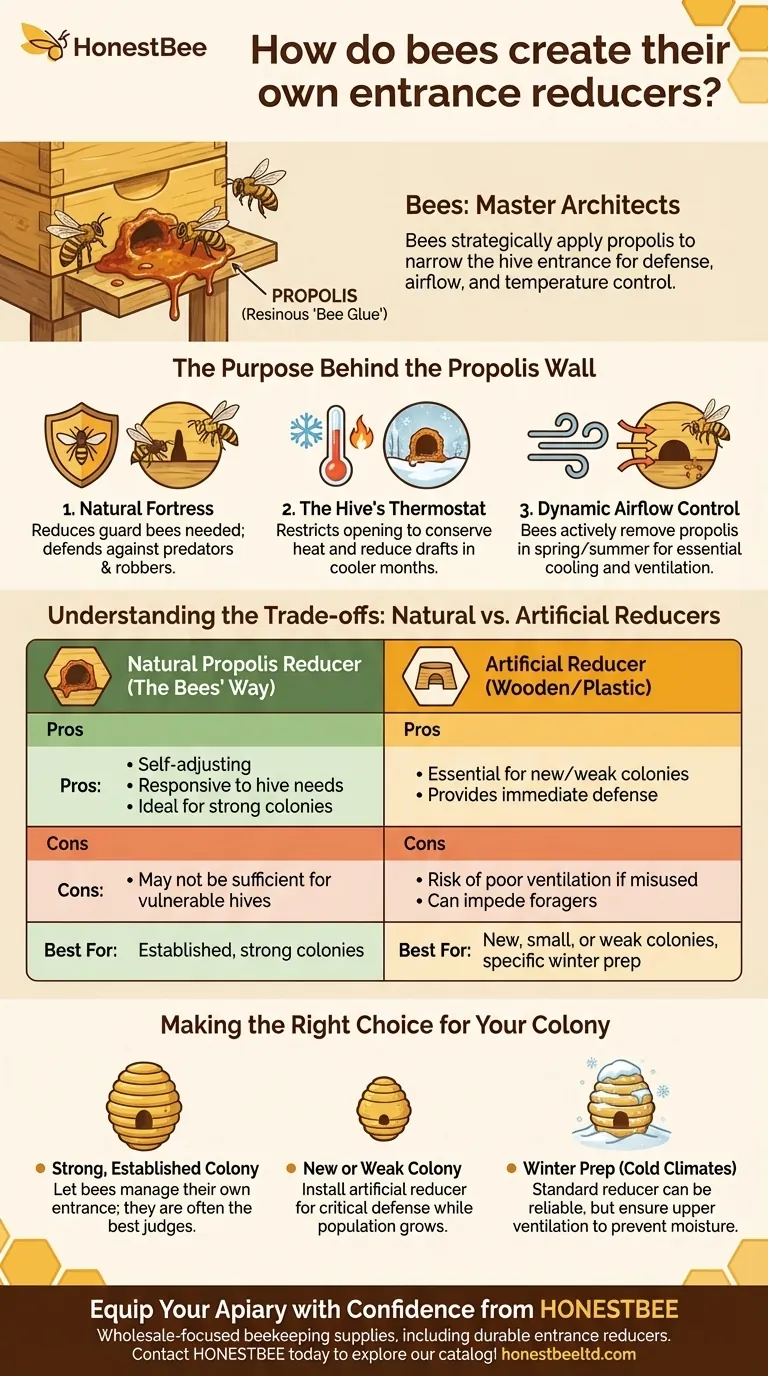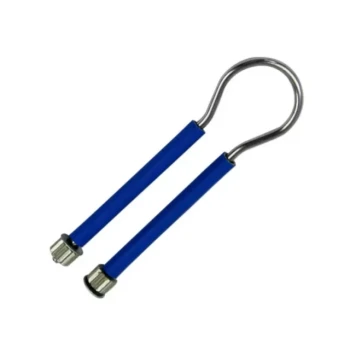Bees are master architects of their own environment. They create their own entrance reducers using a remarkable substance called propolis, a resinous mixture they collect from tree buds and other botanical sources. This sticky "bee glue" is strategically applied to narrow the hive entrance, allowing the colony to meticulously control access, airflow, and internal temperature according to its needs.
A colony's use of propolis to modify its entrance is not just simple construction; it's a vital, instinctual behavior for defense and climate control. Understanding this natural process helps a beekeeper decide when their intervention is helpful versus when it's best to let the bees manage their own home.

The Purpose Behind the Propolis Wall
Bees don't alter their entrance on a whim. This behavior is a direct response to external threats and environmental changes, serving several critical functions for the survival of the colony.
A Natural Fortress
A smaller entrance is far easier to guard. By narrowing the opening with propolis, the colony reduces the number of guard bees needed to fend off predators like wasps and hornets or prevent robbing bees from other hives from stealing their honey.
The Hive's Thermostat
During cooler months, a large, open entrance allows precious heat to escape. The bees use propolis to restrict this opening, reducing drafts and helping to keep the hive warmer. This conserves the colony's energy, as they expend fewer resources to maintain the cluster's critical temperature.
Dynamic Airflow Control
This natural reducer is not permanent. As temperatures rise in the spring and summer, the bees will actively remove the propolis. This re-opens the entrance to increase air circulation, which is essential for cooling the hive and evaporating nectar into honey.
Understanding the Trade-offs: Natural vs. Artificial Reducers
While beekeepers often install wooden or plastic entrance reducers, it's crucial to weigh this intervention against the colony's own abilities. The bees' instinctual use of propolis is often more responsive to their immediate needs.
The Benefit of Trusting the Bees
Some experienced beekeepers choose not to use artificial reducers at all, especially with strong colonies. They trust the bees to modify the entrance as needed, ensuring the hive has precisely the ventilation it requires without the risk of human error.
When Human Intervention is Justified
Artificial reducers are most valuable for new, small, or weak colonies. These hives may not have the population or resources to adequately defend a large entrance, making a beekeeper-installed reducer a critical tool for protection while they build strength.
The Risk of Improper Use
An artificial reducer, if left in place too long or sized incorrectly, can hinder the colony. It may restrict ventilation during hot weather, trap too much moisture during the winter, or create a bottleneck for foragers during a heavy nectar flow, ultimately impeding the hive's progress.
Making the Right Choice for Your Colony
Your decision to use an artificial reducer or let the bees manage their own entrance should be based on the specific condition and strength of each colony.
- If your primary focus is a strong, established colony: Consider letting the bees manage their own entrance with propolis, as they are often the best judges of their ventilation and defensive needs.
- If your primary focus is a new or weak colony: Installing an artificial entrance reducer provides critical defense against robbers and pests while the population grows and establishes itself.
- If your primary focus is winter preparation in a cold climate: A standard reducer can be a reliable part of your strategy, but always ensure there is adequate upper ventilation to prevent moisture buildup.
By observing and understanding the bees' natural ability to modify their home, you can make more informed and effective beekeeping decisions.
Summary Table:
| Natural Propolis Reducer | Artificial Reducer |
|---|---|
| Pros: Self-adjusting, responsive to hive needs, ideal for strong colonies. | Pros: Essential for new/weak colonies, provides immediate defense. |
| Cons: May not be sufficient for vulnerable hives. | Cons: Risk of poor ventilation if misused, can impede foragers. |
| Best For: Established, strong colonies. | Best For: New, small, or weak colonies, specific winter prep. |
Equip Your Apiary with Confidence from HONESTBEE
Whether you manage a single hive or a large commercial apiary, having the right equipment is key to supporting your bees' natural behaviors. At HONESTBEE, we supply durable, beekeeper-tested entrance reducers and a full range of essential beekeeping supplies through our wholesale-focused operations.
Let us help you make the best choice for your colonies. Our experts understand the balance between natural hive management and necessary intervention.
Contact HONESTBEE today to discuss your apiary's needs and explore our wholesale catalog!
Visual Guide

Related Products
- HONESTBEE Professional Multi-Functional Hive Tool with Ergonomic Wood Handle
- Multi-Function Plier-Style Frame Grip Hive Tool
- Professional Dual-End Stainless Steel Hive Tool for Beekeeping
- Professional Stainless Steel Pry-Bar Hive Tool
- HONESTBEE Professional Long Handled Hive Tool with Precision Cutting Blade
People Also Ask
- Why is it recommended to have multiple hive tools on hand? Essential Tips for Efficient Beekeeping
- What is the hole in a hive tool for? A Multi-Tool for Apiary Repairs and Maintenance
- What should beginners consider when purchasing beekeeping equipment? A Guide to Essential Starter Gear
- What are the features of a J-hook hive tool? Effortlessly Lift Frames with Superior Leverage
- What safety precautions are advised for beekeeping with hive tools? Master Safe Handling for Calm, Efficient Hives



















